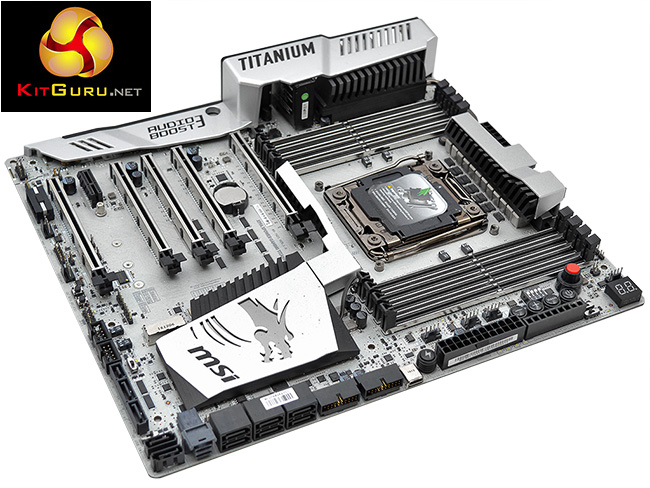The MSI X99A XPower Gaming Titanium is emblematic of the exuberance of the Intel X99 platform, in the same vein as the MSI X99A Godlike Gaming Carbon or ASUS Rampage V Extreme Edition 10. Even by X99-standards it is highly-equipped and somewhat over-engineered, but shows consumers just how many features they could have, and how much hardware they could support, if they are willing to pay the premium required.
The XPower Gaming Titanium, at the time of writing is retailing anywhere from £360 to £400 in the United Kingdom, from reputable retailers, and $350 to $400 in the USA. Such a price point is almost twice that of entry-level X99 motherboards, like the MSI X99A SLI Plus.
Part of the X99A XPower Gaming Titanium's premium positioning stems from its exclusive and eye-catching aesthetic presentation. MSI is the only motherboard vendor to implement a silver colour scheme that includes the PCB – the bold design decision has certainly paid off. The lack of RGB lighting, though, is somewhat questionable at the price point even if the motherboard has a header to support it.

With regards to connectivity it is hard to imagine a user who will be left wanting. Storage is particularly well covered with USB 3.1 (Type A and C), M.2, SATA, SATA Express and hard-wired U.2, rather than it being provisioned by an adapter board. The only omission that comes to mind, which is fairly common for X99 motherboards given its unnecessarily high implementation cost and limited audience, is Thunderbolt.
Networking isn't too shoddy either with Gigabit Ethernet and 802.11 AC, though the lack of dual-Gigabit may disappoint some, especially at this price and considering there is space for it on both the rear I/O and on the motherboard PCB. Most likely though, the omission is a calculated decision stemming from a limited number of PCIe lanes to allocate and a need to keep the cost somewhat competitive.
Where the X99A XPower Gaming Titanium really shines, though, is all the extras that give it overclocking prowess. We've already covered these throughout the review though the tl;dr is that MSI includes buttons, switches and sensors to cover just about every overclocking eventuality from basic air-cooling to advanced LN2.
On the whole the overclocking features are beneficial insofar as they make the building, overclocking and troubleshooting experiences pleasant and hassle-free. In reality, most features will not always used by the average X99 user. It is, however, nice to know that many of them are there if they need to be called upon.

Buy from Overclockers UK for £389.99 inc vat HERE.
Discuss on our Facebook page, over HERE.
Pros:
- Unique and eye-catching design.
- Extensive overclocking feature set.
- Generous PCIe, Storage and USB connectivity.
Cons:
- Considerable price tag.
- Some OC features of little relevance to typical X99 user.
KitGuru says: Stylish and built for overclocking the MSI X99A XPower Gaming Titanium is a worthy consideration for building a top-end overclocked rig.
 KitGuru KitGuru.net – Tech News | Hardware News | Hardware Reviews | IOS | Mobile | Gaming | Graphics Cards
KitGuru KitGuru.net – Tech News | Hardware News | Hardware Reviews | IOS | Mobile | Gaming | Graphics Cards




Why that 6800K stuck at 4.2 ???
Using MSI’s command center and turning off hyperthreading, I’m able to hit a stable & usable 4.6ghz on the X99A Titanium with a 5930k & 32Gb of Corsair RAM @ 2400Mhz. Extended gaming or video encoding with a Corsair H110i GT, the cpu never gets warmer than 58C. This is some very nice gear. I’m quite satisfied with how it all works together, and it looks stunning inside the Enthoo Luxe chassis.
My X99A gaming pro carbon was able to clock the 6800k to 4.2 GHz at 1.251 volts, and 4.1 GHz at 1.194 volts, but 4.3 GHz at 1.3 volts, Windows would crash after booting up. I haven’t tried 1.315 or 1.32 volts yet.
What voltage are you using for the CPU @4.6ghz?